Josef Frank (1885-1967), Founder of Swedish Modern
|

An interview of
Christopher Long, Professor for Architectural
History at the School of Architecture, University of Texas
at Austin. He specializes in the history of modern
architecture, with an emphasis on Central Europe from 1800
to the present. |
Josef Frank is considered as the founder of Swedish design. He said
that “An ornament must be a game, otherwise it is bad and offers the
onlooker no peace.” or that "The living room, where one can
live and think freely, is neither beautifully harmonious nor
homogenous. It has come about through coincidence, will never be
complete and can within itself absorb whatever the residents’
varying needs may require.”
Christopher Long, Professor at the University of Texas, give us an
interview about the ideas and the work of Josef Frank, a designer
who argued that modernism should come from a careful study of the
history and culture of everyday and not from advances in technology.
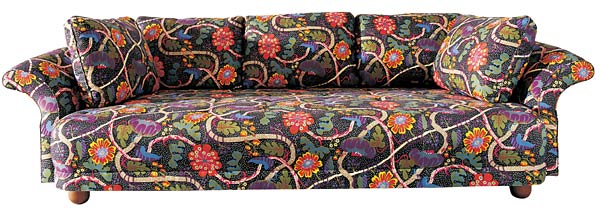
Liljevalchs sofa
The sofa was first shown at an exhibition at the Liljevalch Art
Gallery and Museum organised by the Swedish Handicraft Society in
1934. With its challenging, anti-Bauhaus curves, Frank may have
wanted to signal his presence in Stockholm, or it may have been a
frank and fiery protest against what he called "the usual handicraft
boredom." The sofa, which upset certain arbiters of taste, called
the "Liljevalch sofa or Estrid Ericson’s English cretonne sofa," was
later placed in Estrid’s home on Strandvägen.
L 280 cm, D 140 cm, H 80cm
© svenskt tenn
|
1/ He defied contemporary sensibilities defined by Bauhaus and
modernist designers like Marcel Breuer or Le Corbusier. So what are
the characteristics of Frank’s style ?
|
|
Throughout his career as a designer,
Josef Frank sought to forge a modernism that was responsive
to people’s needs, both physical and psychological. His
furniture was comfortable—he typically used soft,
upholstered seating, rounded edges, and pieces that allowed
their users to relax. He rejected the then common practice
of employing tubular steel, which Frank thought was cold to
the touch and unyielding. But his designs also sought to
respond to our need for the familiar. He did not reject
older, historical forms. Like Loos, he believed that many
things and ideas from the past still had validity. And he
often relied on color and pattern to make his rooms and
individual pieces appealing. |
|
|
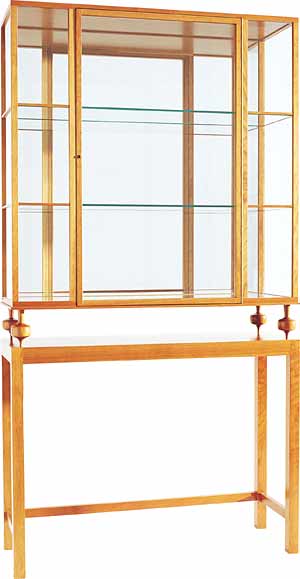
2077 vitrinskap ; the display case
2077 was designed 1946 material : Mahogany ; H 169 cm, W 90
cm, D 31 cm
© svenskt tenn |
2/ We say that he is the
founder of Swedish modern design. But was not there Swedish
modern style before his contribution with Svenkst Tenn ?
What ideas did he bring ?
The Swedes were slow to adopt
modernism, and it was not only in the later 1920s that
modern furniture began to appear in the country. The early
Swedish modernists were drawn to German and Dutch
functionalism—the 1930 Stockholm exhibition featured many
examples of a hard-edged modernism. When Frank began to work
for Svenskt Tenn in the early 1930s, he introduced the idea
of a humane, mitigated modernism. It was this vision of the
new design that eventually began the dominant direction in
Sweden, and which later became widely known as Swedish (or,
sometimes, Scandinavian) Modern.
3/ Has Frank had a different
approach between his first products (fabrics, furniture…)
made in Vienna and the last ones in Sweden ?
Initially, Frank’s work in
Sweden was very similar to earlier Viennese designs. But
within a year or two his work became more colourful and more
varied. His interest in an even brighter color palette was
probably the result of the influence of Swedish folk art,
but it was also undoubtedly a reaction to the dark Swedish
winters. Frank hoped a lighter look would help counteract
the bleak winter days. His work also became more eclectic, a
result of working with Estrid Ericson, the owner of Svenskt
Tenn, who pushed him to explore new design possibilities. |
4/ Did he work in close collaboration with the craftsmen either
did he content with making some sketches ?
|
|
From his earliest days in Vienna, Frank
was very much aware of the requirements and abilities of
craftspeople. He frequently consulted with them, but
typically worked out his many designs—over 2,000 for Svenskt
Tenn alone—on paper, without being directly involved in the
production process. |
5/ Frank has produced a lot of fabrics, furniture, household
products. Did he draw many projects which were not produced ?
|
|
Over the course of his career, Frank
probably produced nearly 2,500 designs. Fewer than half were
ever made, and, of those, only a small number, a few hundred,
were made in larger quantities. |
6/ On the web we see especially Frank’s cabinets. He
nevertheless designed other furniture (tables, chair, armchair…).
Were cabinets his speciality ?
|
|
No, Frank designed many different types
of pieces, from sofas and tables, to lamps and accessories.
He did design a number of cabinets, some of them quite
remarkable, but his true specialty, if he could have been
said to have one, was textiles.
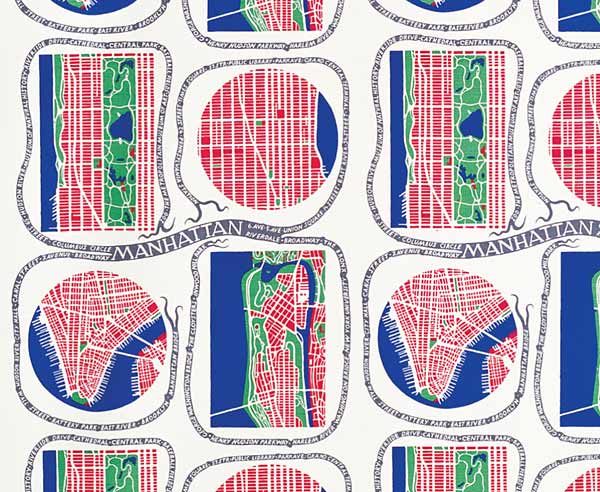
Manhattan
The textile was designed 1943-45 when Frank was living in
New York
© svenskt tenn |
7/ For him, a piece of furniture was to be above all functional
?
|
|
Yes, but functional had a special
meaning for Frank. A piece of furniture was not only
functional because it allowed one, for example, to sit or
recline or write; it also needed to bring pleasure to its
users. That, too, was part of its function. Frank was always
concerned with making furniture and interiors that were
pleasant to inhabit, not just functional in the narrower
sense of the word. |
8/ What are the sources of inspiration of his furniture ?
|
|
Frank was very much a student of
history. He wrote a doctoral dissertation on Alberti, and
throughout his life he studied past forms and ideas. He drew
from a wide array of epochs and traditions, but he was
particularly interested seventeenth and eighteenth English
and American furniture. He also greatly admired American
Shaker furniture of the nineteenth century.

Skap 2170
The chest of drawers was designed 1954
Material : elm burl (root) and wlnut
H 82 cm, W 130 cm, D 45 cm
© svenskt tenn |
9/ Could you describe your favourite piece of furniture of Frank
?
|
|
I don’t really have a favorite design.
I’ve always admired his Biedermeier-inspired chairs and his
later cabinets-on-stand, which borrowed from English and
Shaker ideas. But in the end, it is his ensembles, his
ability to create whole environments, that I admire most.
And my favorite of those is the living room he designed at
Tolvekarna, Estrid Ericson’s country home in Tyresö, Sweden,
from the late 1940s.
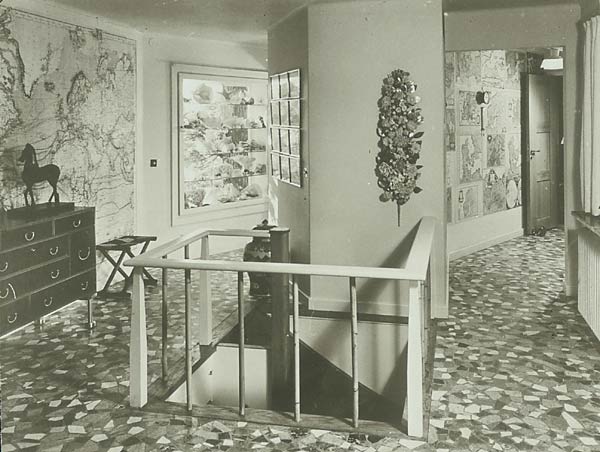
Tolvekarna (Sweden)
interior designed by Josef Frank for Estrid Ericson's house
© svenskt tenn |
10/ Was he successful outside Sweden ?
|
|
Although he made several efforts in his
later years to find a foothold in the United States, Frank’s
work during his lifetime was mostly confined to Sweden. But
because he had a marked influence on other designers in
Sweden, his ideas were disseminated through their works. The
Swedish Modern design of the 1940s, 50s, and 60s, which
became famous around the world, bore the strong imprint of
Frank’s conception of a softened modernism. And when Ingvar
Kamprad founded IKEA in the mid 1960s, the new aesthetic it
offered, a comfortable and humane modernism, became nearly
ubiquitous. Frank’s real legacy is the Swedish style that
IKEA now sells throughout the world. |
11/ For conclusion Christopher, could you explain to us why
Frank’s design interests you ?
|
|
I first saw Frank’s designs at an
exhibition at the Austrian Museum of Applied Art (MAK) in
the early 1980s, when I was studying in Munich. At first, I
found them troubling, a strange, even perverse reading of
modernism. I wrote my dissertation about Frank in part
because I found his work so odd and disquieting. Over the
years, as I came to understand his ideas, I began slowly to
appreciate the designs. But it was not until I spent time in
Sweden, where I saw several intact Frank interiors, that I
grew to like his work. His design for Tolvekarna, in
particular, which I think is a masterpiece of sorts,
awakened in me a true appreciation for him as a designer. |
Svenskt Tenn, éditeur de Josef Frank
|

Table 2139, one of the most sold
furniture of Frank
H 38 cm, D 120 cm
© svenskt tenn |
About
Svenskt
Tenn
Josef Frank did 2000 furniture sketches and donated all
of them to Estrid Ericson and Svenskt Tenn. He mostly used
hardwood and liked to mix different sorts of wood for the
same furniture. One of our most sold furniture is table
2139. We have around 100 pieces of furniture in production
today. And one our of task is to keep our brand contemporary
that is why we have some in production and some not. But we
look in our archive continuously to find new pieces and let
others rest for awhile.
Svenskt Tenn is own by a foundation (Kjell and Märta
Beijer foundation) which funds research in fields of
medicine and science as well as the preservation of cultural
and artistic values in interior design.
You can buy our products here in Stockholm, at Liberty in
London, Just Scandinavia in New York and Beams in Tokyo. And
we also have a web shop at
www.svenskttenn.se
|
Quelques repères de la vie de Josef Frank (1885-1967)
|
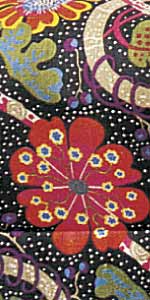
détail du textile Mirakel qui recouvre
le canapé Liljevachs de Josef Frank
©
svenskt tenn |
1885, born in Baden, son of a well-to-do
Jewish textile manufacturer and whosaler
early 1900, he studied architecture at
the Vienna Polytechnic and graduated in 1910
1925, opened Haus & Garten in Vienna
with
Oskar Wlach and Oskar Strnad, a office and shop for interior
design. Many of his textiles created for pour Haus & Garten
will be manufactured later by Svenskt
Tenn
1933, fleeing the rise of nazism, he
left Austria with his Swedish wife Anna and settled Stockholm
Estrid
Ericson had founded in 1924 Svenkst Tenn, a shop originally
featured high quality pewter ware. The collaboration between
Frank and Ericson began in 1934
1934, exhibition of a suite of four
rooms at Liljevalchs (art gallery of Stockholm) designed byr Svenskt Tenn
which was a success
1939, World's Fair in New York where
the Swedish pavilion was reviewed as one of the best
examples of Swedish modern
1940, at the beginning of the war, Anna
and Josef Frank moved to the USA to which his brother
Philipp had already emigrated in 1938. Frank was invited to
lecture at the New School
for Social Research but it was difficult to find American
clients at a time when everything was focused to the war.
His American settlement was not successful
After the war he returned to Stockholm
and continued his collaboration with Estrid Ericson et Svenkst
Tenn
1967, Josef Frank died
|
Des liens
Un livre en anglais
|
|

Josef Frank, Life and Work
by Christopher Long
Editions University of Chicago Press, 2002, 402 pages
An interesting and long-neglected Austrian modern architect,
Josef Frank is important not so much because eof his built
work, but because of his opposition to what the mainstream
of the modern movement in architecture. Christopher Long’s
book will be an excellent contribution to the literature on
the twentieth-century architecture.
|
|











